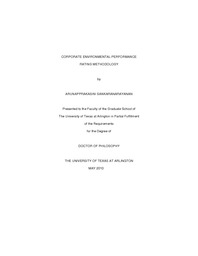| dc.description.abstract | Environmental issues are becoming increasingly important to all kinds of stakeholders and companies themselves, not only for cost avoidance due to regulations, laws, cleanup costs, litigations, controversies, etc, but to improve their intrinsic ethical worth as a company for better environmental sustainability. Off late, companies are increasingly investing in environmental initiatives for cost savings and to generate profits as well. However, since no clear definition of greenness exists, companies are finding it difficult to measure environmental performance as an internal and external benchmark and hence a sound performance measurement system with formal guidelines is yet to be in place. What is measured can be managed and thus, lack of good performance measurement systems has led a need for explicit environmental performance metrics in order to provide stakeholders with more reliable, consistent, and accurate information for comparing companies and making key strategic decisions. While environmental information is becoming available from a growing number of sources, methodological inconsistencies among measures and ratings can inhibit stakeholders' ability to interpret such data and make objective comparisons. Currently, only 2 methodologies exist for corporate environmental performance rating, both of which are generalized, incomplete and lack clear directions for companies to improve their performance and hence improve ratings.The purpose of this research has been to develop a new methodology to rate corporate environmental performances using performance criteria to incorporate all possible range of environmental activities of a company, allocating weights based on a sound weight justification process, assigning standard grades defined with respect to best in class and finally rating real world environmental data for 6 companies in the US retail industry. Potential practical applications of the methodology have been provided. Sensitivity analysis has been performed to see if the weights themselves alter the outcome of grades, with different scenario analyses performed for informed decision making. This apart, environmental data from 6 retail companies in the US have been analyzed to bring out comparisons, issues and insights to help companies improve their environmental performance. Based on this real world data, final ratings have been provided and compared with Newsweek's retail green companies results, since there is no data validation available in this area. The comparison shows marked differences between the rating schemes and proposed methodology's results, primarily due to the narrow range of elements chosen for rating by Newsweek compared to the comprehensive criteria chosen in the proposed methodology for balanced greening and other reasons enumerated in the paper.The outcome ratings show that the new methodology will help companies measure, manage and improve their environmental performance better, inform the different stakeholders to see a clearer picture of how the companies perform against one another and form a basis for enhancing environmental sustainability in the truest sense. | en_US |


